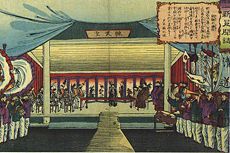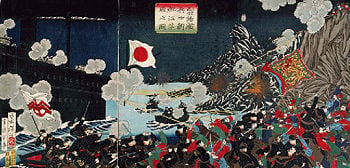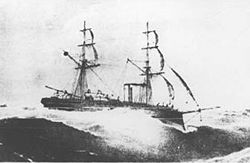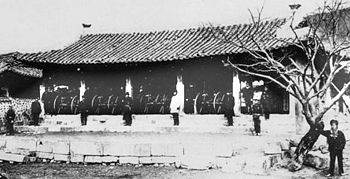Treaty of Ganghwa
| Treaty of Ganghwa | ||||||||
|---|---|---|---|---|---|---|---|---|
 | ||||||||
| Korean name | ||||||||
|
The Treaty of Ganghwa, also known in Japan as Korea-Japanese Treaty of Amity (Jp: 日朝修好条規 (Nicchō-shūkōjōki), signed on February 27th, 1876, was written by Kuroda Kiyotaka, Governor of Hokkaidō, and designed to open up Korea to Japanese trade. It ended Korea's status as a tributary state of China, at least in the eyes of Korea and Japan, if not China, and opened three ports to Japanese trade. The Treaty also granted Japanese many of the same rights in Korea that Westerners enjoyed in Japan, such as extraterritoriality (Japanese in Korea would be subject to Japanese, not Korean, law).
Background
After the Industrial Revolution in 18th century, European nations began to colonize many other weaker nations in Africa and Asia, the political ideology called Imperialism. Almost all of Africa was colonized by European Powers; most of Central, South and Southeast Asia including India was taken over by various European nations. East Asia also was invaded by foreign powers, beginning with the Opium Wars in China by Britain and other foreign powers; China's vast, magnificent empire was reduced to a half-colonized territory. Meanwhile, the American Asiatic Squadron under the leadership of Matthew C. Perry forced Japan to open its ports to the western world in 1854.
Humiliated by unequal treaties and the prospect of losing its independence and integrity to imperialist powers, Japan embarked on a rapid transformation, successfully turning itself from a comparatively medieval society into a modern industrialized state.
Ganghwa incident
In Korea, the strong dictatorship of Daewongun was overthrown by Empress Myeongseong, who instituted a policy of closing doors to European powers. France and United States had already made several unsuccessful attempts to begin commerce with the Joseon Dynasty, all of them happening during Daewon-gun's era. However, after he was removed from power, many new officials who supported the idea of opening commerce with foreigners took power. While there was political instability, Japan developed a plan to open and exert influence on Korea before a European power could. In 1875, their plan was put into action: the Unyo, a small Japanese warship under the command of Inoue Yoshika, was dispatched to survey coastal waters without Korean permission.

On September 20 the ship reached Ganghwa Island, which had been a site of violent confrontations between Korean forces and foreign forces in the previous decade. In 1866, the island was briefly occupied by the French, and also in 1871 subject to American intervention. The memories of those confrontations were very fresh, and there was little question that the Korean garrison would shoot at any approaching foreign ship. Nonetheless, Commander Inoue ordered a small boat launched – allegedly in search of drinkable water. The Korean forts opened fire. The Unyo brought its superior firepower to bear and silenced the Korean guns. Then it attacked another Korean port and withdrew back to Japan.
Kuroda mission

The following year saw a Japanese fleet led by Special Envoy Kuroda Kiyotaka coming over to Korea, demanding an apology from Joseon government and an intercommerce treaty between the two nations. The Korean government decided to accept the demand, in hope of importing some technologies to defend the country from the any future invasions of European powers.
The treaty became the first unequal treaty signed by Korea; it gave extraterritorial rights to Japanese citizens in Korea, the Korean government was to open 3 ports to Japanese and foreign trade, specifically Busan, Incheon and Wonsan and was to establish its independence in foreign relations from China (although it still paid tribute to China).
See also
- List of Korea-related topics
- History of Korea
- Joseon Dynasty
- Imperialism
- Ganghwa Island affair
- Korean-Japanese disputes
ReferencesISBN links support NWE through referral fees
- McDougall, Walter A. 1993. Let the sea make a noise—: a history of the North Pacific from Magellan to MacArthur. New York, NY: Basic Books. ISBN 9780465051526
External Links
- Treaty of Ganghwa. Retrieved August 8, 2007.
Credits
New World Encyclopedia writers and editors rewrote and completed the Wikipedia article in accordance with New World Encyclopedia standards. This article abides by terms of the Creative Commons CC-by-sa 3.0 License (CC-by-sa), which may be used and disseminated with proper attribution. Credit is due under the terms of this license that can reference both the New World Encyclopedia contributors and the selfless volunteer contributors of the Wikimedia Foundation. To cite this article click here for a list of acceptable citing formats.The history of earlier contributions by wikipedians is accessible to researchers here:
The history of this article since it was imported to New World Encyclopedia:
Note: Some restrictions may apply to use of individual images which are separately licensed.

